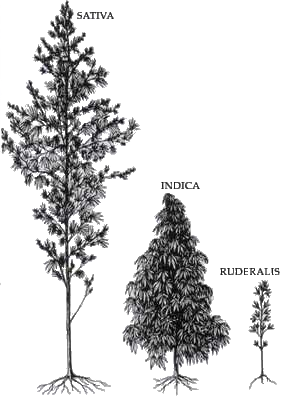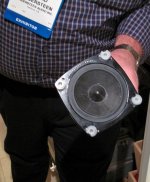Cal Weldon said:Ruderalis is a sativa derivative and might be the hemp to which you allude? Sativa is the mothership that allows it and indica to become psychoactive, no?
There are 3 kinds of Canabis. http://en.wikipedia.org/wiki/Cannabis The actual taxony seems to be in flux.

Ruderalis is a short weed with no drug content and no practical application. It grows wild only -- little study has been done.
Indica is a drug plant (aka Afgani Hash Plants)
Sativa has the most strains from tall and spindly for fiber, heavy seed bearing for food & oil, short & bushy with high THC content...
Entrepnerial bbotonists have developed all sorts of sativa/indica crosses.

dave
Thanx Dave, I was aware that sails were made from Hemp, but at the time that L.Strauss made his first dungarees I thought that most cloth was starting to be made from cotton because an industrial and mechanised method of spinning and carding the fibre had been developed which was making the use of hemp fibre uneconomical.
Like nettles hemp needs to be retted for a very long time ( in salt water ) to make the fibres strong and supple, where-as cotton was usable as soon as picked
Like nettles hemp needs to be retted for a very long time ( in salt water ) to make the fibres strong and supple, where-as cotton was usable as soon as picked
I hope no one starts smoking speaker cones soon 
Anyway I think this article about cone material is quite popular. I really like the insights and examples given:
http://www.nutshellhifi.com/library/speaker-design2.html
Anyway I think this article about cone material is quite popular. I really like the insights and examples given:
http://www.nutshellhifi.com/library/speaker-design2.html
Kevlar cones are a good bet. I've had a few from different manufacturers and all have worked with a 1st order xover, with the exception of one which seemed to produce a smoother response curve with no xover!
However, there seems to be a distinctive tonal quality which seems to emphasise the lower midband and upper bass frequencies.
In terms of sound quality, the good old paper cone seems, to my ears, the best, especially when it comes to speech material. I've managed low order xovers with paper as well.
However, there seems to be a distinctive tonal quality which seems to emphasise the lower midband and upper bass frequencies.
In terms of sound quality, the good old paper cone seems, to my ears, the best, especially when it comes to speech material. I've managed low order xovers with paper as well.
I hope no one starts smoking speaker cones soon
i'm looking who smoke at first.L
Kevlar cones are a good bet.
delphiplasma, the only one of manufacture in thailand used them a long time(20 years). they used Kevlar cones for mid-bass(5-6.5") and subwoofer 10"
http://www.soundstage.com/revequip/songaudio_typeiisilkdm.htm
rohacell, with carbon fiber covering,
may well be the new 'hi-end'
cone material ...
http://images.google.com/images?hl=...acell carbon fiber&um=1&ie=UTF-8&sa=N&tab=wi
http://www.clarasonic.com/en/rohacell_2.php
the 4th kind.
altho most people call these 'Acer Palmatum',
the teenagers in the old hood knew,
this was 'Red Bud'
853
noted designer w/rohacell sandwich cone driver -
may well be the new 'hi-end'
cone material ...
http://images.google.com/images?hl=...acell carbon fiber&um=1&ie=UTF-8&sa=N&tab=wi
http://www.clarasonic.com/en/rohacell_2.php
There are 3 kinds of Canabis.
the 4th kind.
altho most people call these 'Acer Palmatum',
the teenagers in the old hood knew,
this was 'Red Bud'
An externally hosted image should be here but it was not working when we last tested it.
An externally hosted image should be here but it was not working when we last tested it.
An externally hosted image should be here but it was not working when we last tested it.
853
noted designer w/rohacell sandwich cone driver -
Attachments
Thank you all for your contributions. I have found this very useful. From my experience, paper presents as the most subjectively neutral. However, this may be that its character coincides with my accepted and expected neutral sound, having grown up listening to mostly paper drivers. But, I have heard my share of live music, too!
Modern 'rigids' seem like the next logical step, though I do love polypropylene, admittedly for looks as well as its highly (sometimes overly) dampened tonality. I would like to give Kevlar drivers a whirl, also.
JF
Modern 'rigids' seem like the next logical step, though I do love polypropylene, admittedly for looks as well as its highly (sometimes overly) dampened tonality. I would like to give Kevlar drivers a whirl, also.
JF
454Casull said:It's my opinion that everything sounds the same if operated in the pistonic region.
me too!
tomtt said:rohacell, with carbon fiber covering,
may well be the new 'hi-end'
cone material ...
http://images.google.com/images?hl=...acell carbon fiber&um=1&ie=UTF-8&sa=N&tab=wi
http://www.clarasonic.com/en/rohacell_2.php
i tried contacting clarasonic but no reply. Are they still in business?
I'm a real supporter of hard cone material, so I use Accuton ceramics mid and low drivers and Focal beryllium tweeters in my so called "reference" speaker; but I asked allways myself WHY manufacturers do not directly apply some thin dampening layers, assuming the lost efficiency would not be as huge...
Because normally it is quite huge when the damping becomes effective. Especially on drivers with higher frequency extension.crazyhub said:I'm a real supporter of hard cone material, so I use Accuton ceramics mid and low drivers and Focal beryllium tweeters in my so called "reference" speaker; but I asked allways myself WHY manufacturers do not directly apply some thin dampening layers, assuming the lost efficiency would not be as huge...
I thought the higher the resonance in frequencies, the easier its dampening (whatever the Q)...soongsc said:
Because normally it is quite huge when the damping becomes effective. Especially on drivers with higher frequency extension.
"but I asked allways myself WHY manufacturers do not directly apply some thin dampening layers, assuming the lost efficiency would not be as huge..."
JBL does on Titanium, Aluminum and Berylium diaphrams. They use coated tweeters and coated diaphrams in some of their compression drivers. The diaphrams are thin so the coating can be thin as well. It works well too and you don't loose that much efficiency.
Rob
JBL does on Titanium, Aluminum and Berylium diaphrams. They use coated tweeters and coated diaphrams in some of their compression drivers. The diaphrams are thin so the coating can be thin as well. It works well too and you don't loose that much efficiency.
Rob
I've looked at drivers where the resonance is generally in the 20K~25KHz range. So far, the most effective seems to be finding a way to break up the mode rather than pure damping.crazyhub said:I thought the higher the resonance in frequencies, the easier its dampening (whatever the Q)...
- Status
- This old topic is closed. If you want to reopen this topic, contact a moderator using the "Report Post" button.
- Home
- Loudspeakers
- Multi-Way
- Cone Materials Discussion
